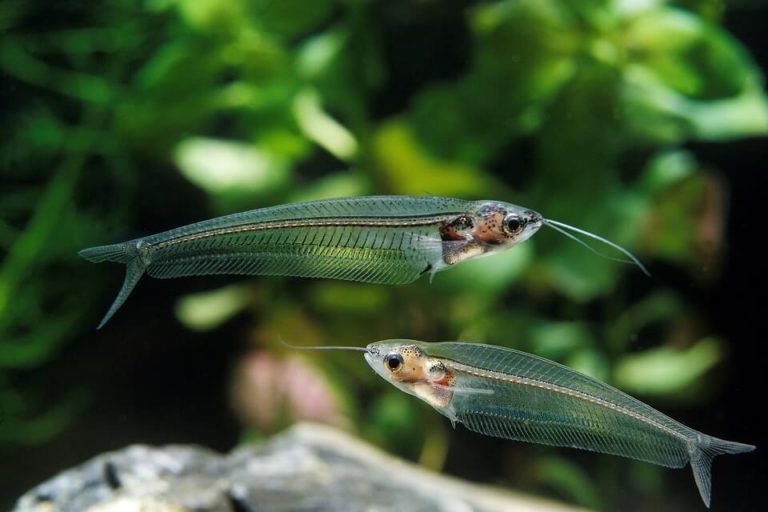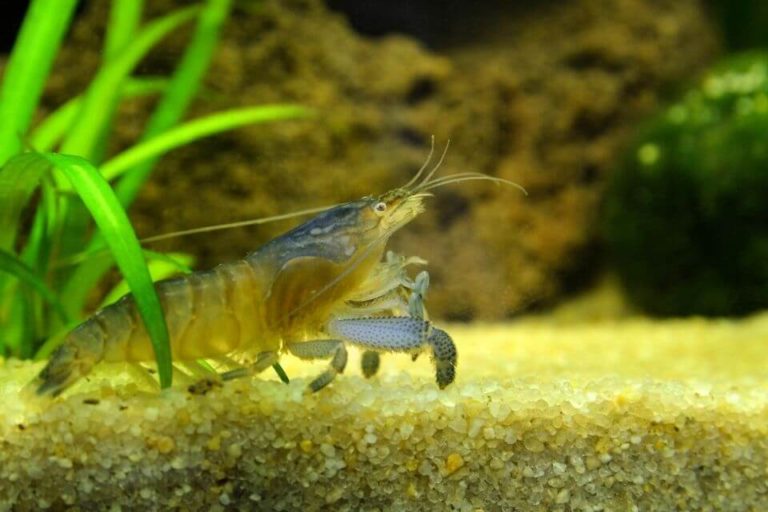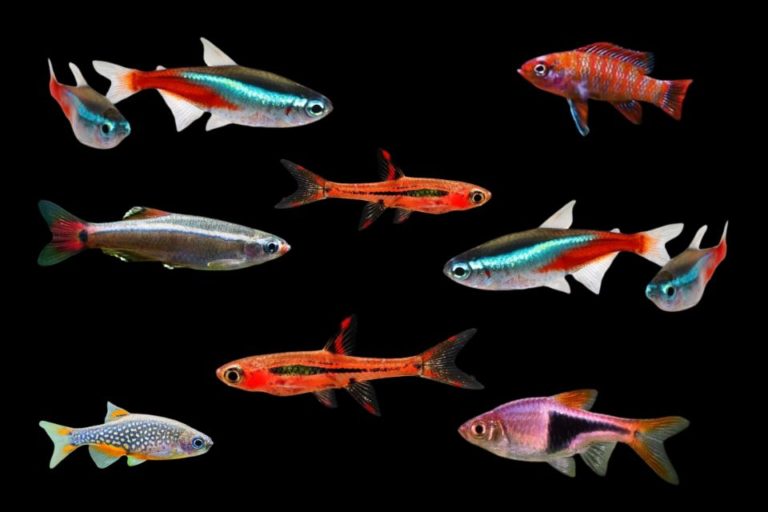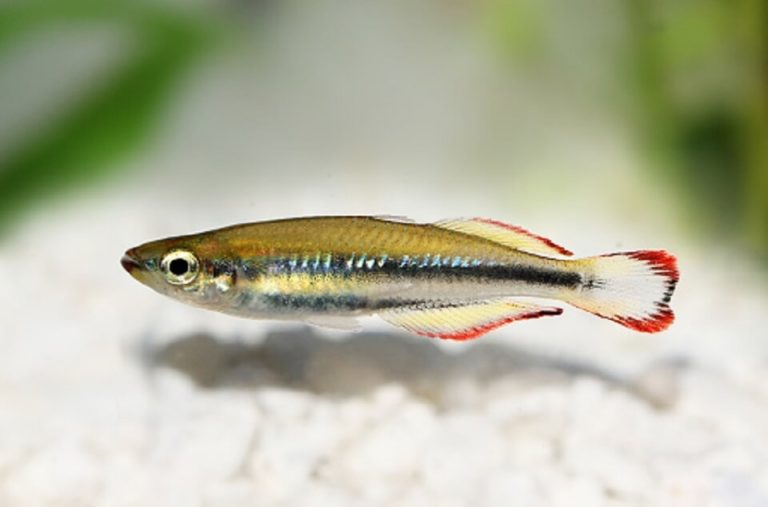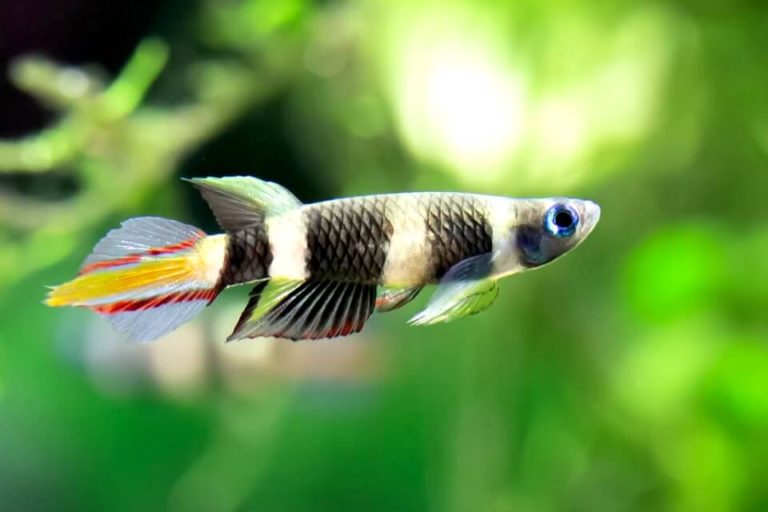Bolivian Ram Cichlid Care: Size, Lifespan, Food, Tank Mates, Tank Size
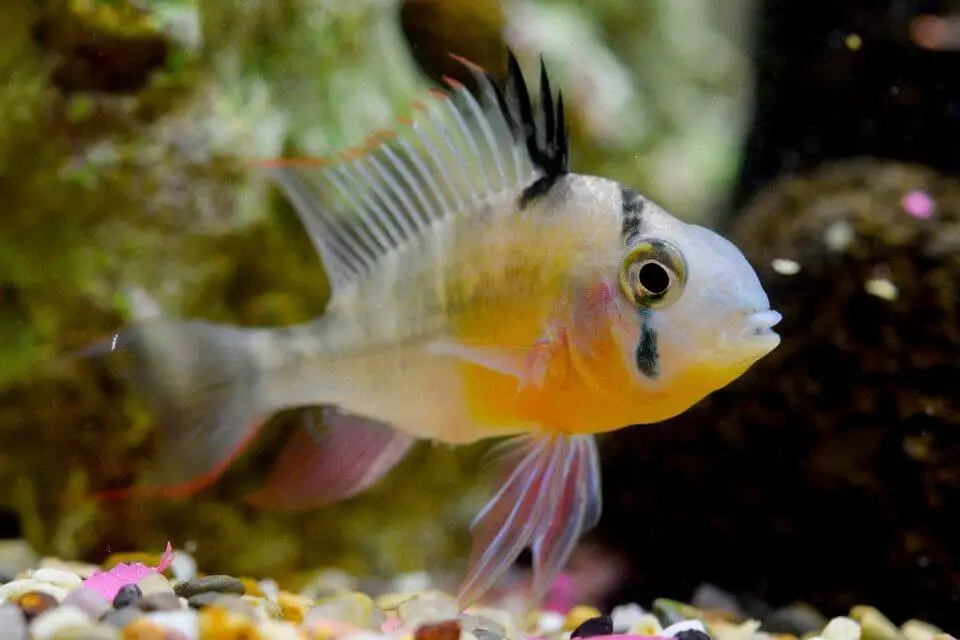
Bolivian Ram Cichlid is an interesting freshwater fish species that are commonly found in the Amazon River basin. These popular cichlids are liked by many because they are attractive and easier to take care of.
Moreover, people prefer them because they can be kept in a community tank. Unlike other fish species, the Bolivian Ram fish can quickly adapt to different water environments.
If you’re a beginner who is interested in keeping this Cichlid species, here is a guide of everything you should know about Bolivian Ram care.
| Quick Facts: | |
|---|---|
| Common Names : | Bolivian Ram, Bolivian Ram Cichlid, Bolivian Butterfly, Ruby Crown Cichlid |
| Origin : | Amazon River basins in Bolivia through Brazil |
| Family : | Cichlidae |
| Scientific Name : | Mikrogeophagus Altispinosus |
| Care Level : | Easy |
| Temperament : | Peaceful, but can be little aggrassive during spawning |
| Social : | Community friendly fish |
| Diet : | Omnivores |
| Size (average) : | 2.5 - 4 inches |
| Lifespan : | Up to 4 years |
| Breeding : | Egg layer |
| Minimum Tank Size: | 20 gallons (approximately 75 liters) |
| Tank Environment : | Freshwater, Pebbles or sand substrate, Driftwood and rocks for decorations, Live aquarium plants or Silk plants |
| Temperature : | 72°F to 79°C (22°C – 26°C) |
| Water Hardness : | 6 -14 dGH |
| Water pH Level : | 6.0 – 7.5 pH |
Species Overview
It was first discovered in 1911 and was initially named “Crenicara altispinosa”. Later in 1977, the binomial name was changed to the current name Mikrogeophagus altispinosus.
Bolivian Ram Cichlid has other common names and is Bolivian Butterfly and Ruby Crown Cichlid.
Unlike other Cichlid species, Bolivian Ram fish are very peaceful and can quickly get along with other species. Bolivian Ram Cichlid belongs to the Cichlidae family and is prevalent in the aquarium trade.
When Bolivian Ram Cichlid is placed in the right water conditions and is well taken off, they can live up to 4 years. Though this species is primarily found in Bolivia, it is also available in Brazil’s tropical freshwater bodies.
Bolivian Ram Size
Typically, a mature Bolivian Ram size measures around 3 inches in length in the captivity settings. However, the male Bolivians are more extensive and can measure up to 3.5 inches when fully grown in their natural habitats.
On the other hand, most female Bolivian Ram size rarely reaches the average 3 inches in length. Most of the female Bolivian Ram size stays closer to 2.5 inches when fully grown in a captivity environment.
Bolivian Ram Lifespan
Bolivian Ram lifespan depends on how well they are taken care of. The average Bolivian Ram lifespan is around 4 years in an aquarium. In their natural habitats, Bolivian Ram lifespan is expected to be around 6 years.
Behavior and Temperament
They are peaceful Cichlid species by nature. They are mostly known and liked for their friendly and intelligent demeanor. Unlike other Cichlids that are a bit aggressive, Bolivian Ram fish are nice and community-friendly.
If you closely observe them in a tank, you will notice their unique swimming pattern. These Cichlids first move for a few strides before they proceed and continue with this pattern over and over.
You will see this unique swimming pattern when feeding because they always need to move through the substrate without stirring it up. If they notice a predator, they quickly switch their graceful swimming and start swimming faster.
Appearance and colors
Bolivian Ram Cichlids have several distinct physical appearances. Their elongated oval body distinguishes them from other species. Moreover, they are widest around the pelvic and dorsal fins, and the shape tapers down at the tail fin.
At first glance, you’ll notice their relatively muted color. The fish has a subtle yellow color towards the belly and has silver or tan coloration at the base. If you take a closer look, you will see a vertical black stripe covering the head.
Apart from finding faded black stripes that run vertically along the body, you will notice the unique color pattern on their fins. Their rayed, sharp fins help in defending themselves against predators.
If you check the front part of the dorsal fin, you will find a small black stripe. The rest of the dorsal fin is clear and transparent with bright red edges. The red edging is also found on the tail fin.
The pelvic and anal fins have a more red appearance, complemented by a light pearly blue appearance.

Bolivian Ram Care
Taking care of Bolivian Ram fish is not that hard. They quickly adapt to new water conditions, and you won’t have problems with slight water fluctuations. However, it’s crucial to stick to their preferred requirements for the health of the fish.
Ensure that the water is well oxygenated and clean. Keeping dirty objects in their tanks will attract fungal and bacterial infections that can be dangerous to your fish. Remember, you should not overcrowd your tank with other fish to avoid stressing them.
– Bolivian Ram Tank Size
Most people recommend keeping a Bolivian Ram tank size that can hold around 20 gallons of water. However, you can build a 30 gallons tank so that your fish can have a big tank where they can swim and explore.
If you are planning to keep many Bolivian Ram Cichlids, you should increase the size of the tank so that every fish will have its own space.
Fast Setup, Whisper Quiet, Continuous Water Flow
Buy Now ➮
– Bolivian Ram Tank Setup
Although the Bolivian Ram Cichlids are hardy fish, you should provide them with ideal conditions. The best way to keep them comfortable is by mimicking their natural habitat.
Mostly, you will find these species living in lagoons and streams with dense vegetation that offer them shade and shelter.
Just like their natural habitat, your tank should have a few aquarium plants, plenty of rocks, wide swimming spaces, and other hiding places. You can use fine sand and some pebbles as substrate.
You can create some caves within stones so that the fish can find breeding grounds. They like hiding their eggs where other species in the tank can’t reach. Alternatively, you can buy a faux rock décor where your fish will enjoy swimming across.
– Water Conditions and Parameters
Bolivian Ram prefers living in areas with low lighting and slow water movements. Bolivian Ram temperature requirement of their tank is pretty much closer to the German Blue Ram temperature requirement.
Always ensure the water has temperatures of 72 to 79 degrees Fahrenheit (22°C to 26°C). Ensure you provide enough water changes so that the nitrates levels are in check.
If you add a new Bolivian Ram fish, ensure you add an extra 5 gallons to avoid disrupting their habitat. You need to maintain a pH level of between 6.0 and 7.5 for them to survive in the tank.
Moreover, ensure the hardness of the water in the tank is between 6 and 14 dGH. It is a must to have aquarium water testing KIT handy when you plant to have a fish tank in your home.
- Water temperatures range: 72°F to 79°C (22°C – 26°C)
- Water hardness range: 6 -14 dGH
- The acidity level of the water: 6.0 – 7.5 pH
– Suitable plants
You can fill your tank with aquatic plants like;
- Amazon Sword
- Java Fern
- Water Wisteria
- Anubias Nana
- Anacharis
Moreover, you can add floating aquarium plants so that they can find somewhere to rest and hide while plants also reprieve your fish from light.
Possible Diseases and Prevention
Bolivian Ram Cichlids are known to be vulnerable to diseases if the water in the tank is stale and has low oxygen levels. Mostly, they get infected with a condition known as ICH that makes their gills, fins, and whole-body have white spots.
However, you can treat the disease by increasing the temperature of the water to 86 degrees Fahrenheit for three (3) consecutive days. If the method doesn’t work, you can use over-the-counter copper-based medicines to treat them.
Another common disease that attacks this fish family is Skin Fluke. Skin fluke is an infection commonly caused by parasites such as protozoa, bacteria, and fungi.
Experts recommend you quarantine any fish before you put it in the tank where Bolivian Ram Cichlids are. However, if they still get infected even after taking all the necessary precautions, you can seek veterinarian help.
Most of these diseases are contagious. If you suspect that a particular fish is infected, you should quarantine it to avoid spreading the infection to healthy fish.
Bolivian Ram Food and Feeding
These fish are omnivorous and can consume almost all types of food you give them. When in the rivers, ponds, and lagoons, they primarily consume riverbed detritus, small invertebrates, and different plant matter.
However, when placed in tanks, you can feed them dry food, chopped-up earthworms, and brine shrimp. Since they like living at the bottom of the aquarium, ensure the food you give them sink to the bottom.
If you take a closer look when they’re feeding, you will notice that they like sifting through the substrates. They enjoy taking a mouthful of the substrate and then expelling it through their mouth and gills.
Ensure you include the following items in their diet.
- White Worms
- Brine Shrimps
- Cyclopeeze
- Bloodworms
- Chopped Earthworms
- Tubifex
- Daphnia
- Blanched vegetables
As far as the number of feeding times is concerned, you can give them small portions 2 to 3 times a day. Interestingly, if you give them one large amount daily, the chances of deteriorating the tank’s water are more than when you feed them small portions.
Gender Differences
It becomes reproductive between the age of 9 and 10 months. However, their young ones have no gender dimorphism. Although it’s pretty hard to distinguish the male and female Bolivians, the males are more significant and brighter.
Moreover, their dorsal fins are long and pointed. You have to take a closer look for you to notice these distinctive features.
Bolivian Ram Breeding
Bolivian Ram Breeding is straight forward and they breed their own when provided with the proper water conditions. When in the wild, they are known to form a family and lay around 100 eggs.
To breed them in water tanks, you will have to find a mated pair and place them in their tank. Next, create a favorable environment to encourage spawning. Keeping them in a separate tank helps you to maintain the necessary mating conditions.
When preparing their tank for breeding, ensure the tank has about 50 gallons and has many hiding spots. You can put broad leaves, large stones, snags, and smooth pebbles to act as their hiding place.
Next, set the water temperature between 77 to 82 degrees Fahrenheit, and ensure the hardness of water is 10 dGH. The pH level should be about 7 to 7.5, and make sure you have minimal light settings.
Once the pair is ready for mating, you will see them preparing the area several times before spawning. The male Bolivian Ram Cichlid usually creates a pit that will keep their fries after hatching.
When the female Bolivian Ram is ready for breeding, it will go to the spawning site and lay around 200 eggs. The male will then protect the eggs from being eaten by the predators.
After the male fertilizes the eggs, both genders will fan the eggs. Most eggs hatch within the first 60 hours. Then, the fries will start swimming after seven days.
However, their parents are responsible for training them to swim correctly by carrying them to different locations using their mouths. When the Bolivian Ram breeding for the first time, you will see them eating their eggs.
Don’t be discouraged because they will stop doing that in their second attempt. If you would like to feed the fries, you can give them Shrimp Nauplii or Vinegar Eels.
Bolivian Ram Tank Mates
When you are choosing Bolivian Ram tank mates, you must consider their behavior. Because they are peaceful Cichlid species you have to choose peaceful fish species as Bolivian Ram tank mates.
If you place the Bolivian Ram Cichlids with aggressive tank mates, they can struggle living there and will reduce Bolivian Ram Cichlid lifespan.
Below list of peaceful fish species that make the best Bolivian Ram tank mates;
- Guppies
- Corydoras Catfish
- Silver Dollar fish
- Tiger Barb
- Odessa Barb
- Zebra Pleco
- Rummy Nose Tetras
- Dwarf Gouramis
- Cherry Barbs
- Rosy Barbs
- Zebra Danio
- Swordtail Fish
- German Blue Ram
Before you keep them with other species, ensure you’ve placed them in a specious tank to avoid being preyed on easily.
Origin and Distribution
As their name suggests, Bolivian Ram Cichlids originated from Bolivia, South America. The first specimen was collected in a shallow pond in Bolivia.
However, the fish is also available in Guarpore Basin in San Ramone, the flood plains near Todos Santos, and at the mouth of the Rio Guarpore River. These species are evenly distributed across tropical water bodies in Bolivia and Brazil.
You can find them in lakes, river tributaries, lagoons, backwaters, streams, and pools with sandy or muddy substrate. They like living near thick water vegetation because such habitats offer shade and hiding spots.
These cichlid species also like inhabiting the bottom areas of slow-moving water bodies.
Frequently Asked Questions
Should Bolivian Rams Be Kept In Pairs?
Since the Bolivian Ram Cichlid does not show schooling behaviors, keeping in small groups of 6 to 8 in a tank is advisable. Keeping a pair of male Bolivian Ram fish with a female fish is another option to keep if you have small tank space.
Are Bolivian Rams Schooling Fish?
Unlike other fish species, the Bolivian Ram Cichlids do not prefer to be in a school. But, they prefer staying with other Bolivian Ram Cichlids in a group.
Are Bolivian Rams Aggressive?
Bolivian Ram fish are known to be very peaceful. They only show aggression during the breeding session. Moreover, they get aggressive when other fish go near their breeding area. If not provoked, they get along very well with other peaceful species.
What Is The Difference Between Bolivian Ram Vs German Blue Ram?
– Size and Appearance
Although both species are colorful fish, they don’t have the same appearance. Compared to the German Blue Ram, you will find that the colors of the Bolivian Ram fish are less colorful.
Moreover, in terms of size, the German Blue Ram is smaller compared to the Bolivian Ram fish. German Blue Ram never grows more than 2 inches in length, while the Bolivian Ram Cichlid can grow up to 3.5 inches.
– Typical Behavior
Although both species are known to be peaceful creatures, the Bolivian Ram Cichlids are shyer. They like spending most of their time in the lower part of the tank.
Unlike the Bolivians, the German Blue Rams are daring and spend most of their time swimming in every corner of the tank. The Bolivian Ram Cichlids have a unique swimming pattern.
Unlike the German Blue Rams, the Bolivian Ram fish like swimming for a few strokes and then stop swimming and repeat the same routine all day long.
Another difference between these two species is their feeding habits. While the Bolivian Ram fish can eat almost everything they come across, the German Blue Rams are picky and selective.
– Water Temperature and pH
The water temperature and pH requirements for these species are different. The German Blue Rams like living in warmer temperatures of about 78 to 85 degrees Fahrenheit.
They also like living in subdued light and a pH of about 6-7.5. On the other hand, the Bolivian Ram Cichlids can quickly adapt to different water environments.
Another distinct difference between the two species is the amount of space required for each Ram. Bolivian Ram fish survive better in bigger tanks that can accommodate 30 gallons per fish.
German Blue Ram requires less water around 10 gallons per fish in the tank.
Can Bolivian Rams Live With German Blue Rams?
You can keep both species in the same tank. However, they prefer living in slightly cooler water, while the German Blue Ram prefers warm water. That’s why it’s not a good idea to keep them in the same tank.
Where Are Bolivian Rams For Sale?
These Cichlid fish are widely sold both in aquatics and online. You can get them on reputable online platforms like eBay. Bolivian Fish are common in South America, and for you to get good spacemen, you will have to pay around $10 per fish.
Final Thoughts
Bolivian Ram Cichlids are adorable creatures and the most peaceful fish species. Apart from their attractive appearance, they are easier to take care of. Their graceful, unique swimming pattern will give your aquarium a new, magnificent look.
Moreover, since they are not aggressive, they can easily live with other peaceful fish species. These Cichlids are not picky eaters and have minimal dietary requirements.
If you want to breed this species, you’re only required to put them in a group of 6 to 8 and wait until they pair. Upon pairing, you need to put them in a separate tank.
So what are you waiting for? Get the Bolivian Ram fish and add them to your aquarium.














